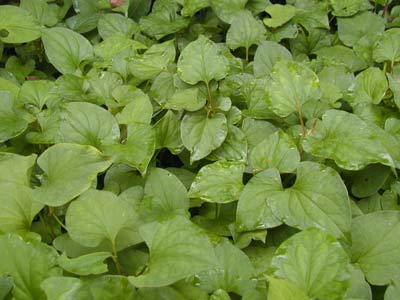 |
|
Cordate houttuynia |
Cordate houttuynia is a vivacious herbal plant; it has its Chinese name - "fishy grass" because its leaves and stalks can give off the smell of fish after rubbing. Cordate houttuynia scatters widely in the southern provinces of China; we can also find its distribution in Northwest China, and parts of North China and Tibet. Cordate houttuynia usually grows in shady slopes, on the ridges of crop fields, riversides, or humid grassland. When cordate houttuynia plant is young, the part under its neck crawls on the ground surface and looks like root growing in shallow soils, and it is white and has roots beside the joints. The upper part of its stalk stands upright, which is heart-shaped or egg-shaped and green and purple in color. The flowering period of cordate houttuynia is from May to June, and its fructifying period is from October to November. Cordate houttuynia has great vital forces; they can survive by just inserting a piece of roots or stalks into humid soil, and its branches can also sprout and regenerate when inserting into soil.
In Xishuangbanna, cordate houttuynia is a kind of normally seen wild vegetable, and most local folks like to have it. Normal cooking methods include: method a. get rid of the woolly roots on the stalks, cut them into small sections of 2-3 cm in length after cleaning (some young leaves can also add into it), put in some vinegar, sauce, pepper powder, and monosodium glutamate, then mix them up; the dish is crisp, but has a fishy smell. Method b: use its underground stalk and young leaves to fry, boil, or braise; in this way, it gives off a faint fragrance, but is still a bit fishy. Method c: make them into pickled vegetable; in this way, the dish is crisp and appetizing.
Wild cordate houttuynia has a strong fishy smell, and people who first eat it do not feel it so tasty. Its underground stalks are rich in fibers, and people do not feel so yummy when eating; therefore, its development towards a commercial vegetable still lags behind. The first people to take cordate houttuynia as food are mostly doctors who understand its medical functions. In the recent years, affected by fashions of "going back to nature" and "taking medicinal foods", the trend for common people to collect cordate houttuynia as wild vegetables become more and more prevailing, particularly in Yunnan, Sichuan, and Guizhou etc. The scale for developing cordate houttuynia continues to expand, because wild resources can not satisfy the demands at all. The price of cordate houttuynia on the market looks to further increase. For the time being, in order to mitigate the contradiction of demands and supply, some artificially planted cordate houttuynia begin to appear on the market, and this has to some extent reached a certain production scale. Since cordate houttuynia is on its way of changing into a cultivated vegetable, its living conditions are greatly improved. As a result, its growing circle becomes shorter, its plants grow more quickly, its underground stalks become thicker, and its starch contents improve to a certain extent. On the other side, its fiber contents reduce in large extent. So, when we eat it now, we may feel it is tender and yummy; because the fishy smell becomes faint and the dainty improves.
In Xishuangbanna, cordate houttuynia is also a traditional medicinal plant. Most folk doctors believe it has a cold nature, and has the effects of clearing heat, detumescence, and diurisis. It is often used to cure cankers, to clear heat, and to cure dropsy and whites etc. Besides, cordate houttuynia is also a major medicine for curing pulmonary diseases and urinary diseases.
Modern medicinal people have further understandings about cordate houttuynia: its peculiar fishy smell comes from an effective element in its volatile oil - decanoy acetaldehyde, which is the major antibacterial element in cordate houttuynia. Clinical experiment proves: cordate houttuynia has good curative effects for infection of the upper aspiratory cavity, bronchitis, arthritis, and cough etc. and it also has certain curative effects to conjunctivitis and infection of the urethral channel. Besides, cordate houttuynia can improve the immunity of the body and the gulping capacity of the white cells; therefore, it may also has the effects for stopping pains, cough, and bleeding, as well as facilitating the regeneration of tissues, enlarging capillary vessels, and improving blood circulation etc.
Cordate houttuynia can be planted as a vegetable. If it is further developed, it can also be used as medicinal materials for manufacturing Western and Chinese medicines; therefore, it may enjoy a broad market prospect in the future.


|